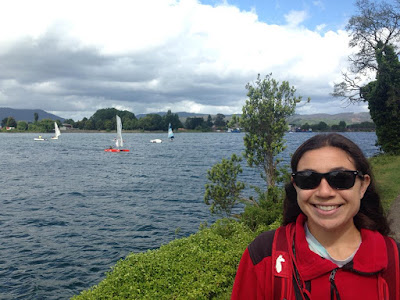 |
| Pucón and Volcán Villarrica |
 |
| Landing in Valdivia |
We flew to Valdivia and took the bus from there to Pucón. Our AirBnB hosts were quick to tell us what we had already discovered- nobody goes to Pucón through Valdivia. Instead, the established route is from the other regional hub, Temuco. Buses leave all the time from Temuco to Pucón, whereas we had to wait around for 3 hours in Valdivia for a bus. Note that both Temuco and Valdivia are about 2 hours to Pucón by car. Our extra time in Valdivia was not wasted, however. We had a good time looking around at the sea lions and getting a beer in German-influenced Valdivia, the center of Chile's craft beer industry.
 |
| Downtown Valdivia is delineated by the Calle-Calle and Valdivia rivers, which make for a scenic coastline! |
We started our first day in Pucón bright and early by catching a bus to the Ojos de Caburgua, two pools of very blue water. And they were very blue... but really they're just a couple of little ponds.
 |
| The Ojos de Caburga were bluer in real life than they appear in the photo, but they were a bit underhwelming. |
We started chatting with a Chilean couple (also underwhelmed by the Ojos de Caburga and instead entertaining themselves by photographing local birds). Our next planned stop was Lago Caburgua and it's famous Playa Blanca and Playa Negra. The Chileans decided to come with and we enjoyed a nice conversation with them for the next few hours! They run their own small, construction business out of the Chilean town of Chillán.
 |
| Our new friends |
 |
| There's a pleasant 30-minute hike between Playa Negra and Playa Blanca |
 |
| Playa Negra looks like Playa Blanca at Lago Caburga |
 |
| Lago Villarrica Beach in Pucón- Many of the mountains in this region were formed by glaciers. We're not exactly sure why, but their rocky edges and green faces look tropical to us. |
All in all, our first day felt a little like a dud. But now that we had the lay of the land, we came back to Huerquehue the next day and set off as soon as it opened. And it's a good thing we got such an early start because the only open trail took us 7 hours of continuous hiking (and we didn't even do the whole thing!). It passed two waterfalls, a few lookouts with impressive views of the nearby lake and volcano, and ended at a circuit of a few lakes. It's the hardest hike Karen's done in years, so kudos to her!
Sites from a farm/hostal near the entrance to Huerquehue National Park.
 |
| These geese(?) were HUGE and protective of their babies |
Sights from the Trail- We passed 4 lakes, 2 waterfalls, and of course, saw lots of views of Volcán Villarrica.
An Araucaria branch










No comments:
Post a Comment
Note: Only a member of this blog may post a comment.